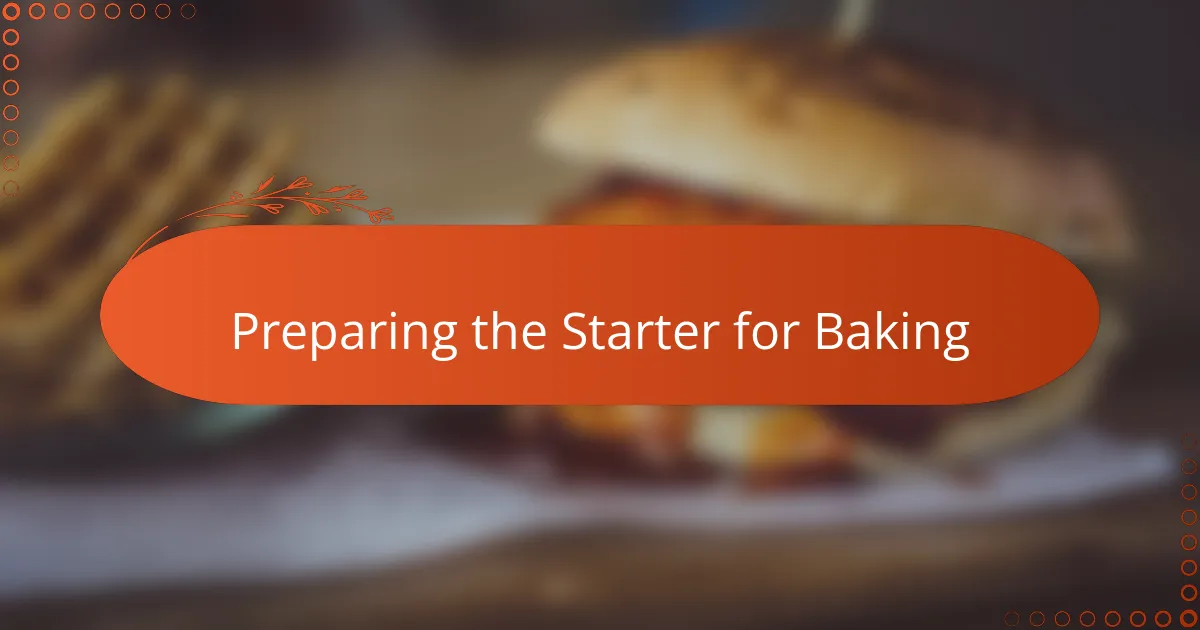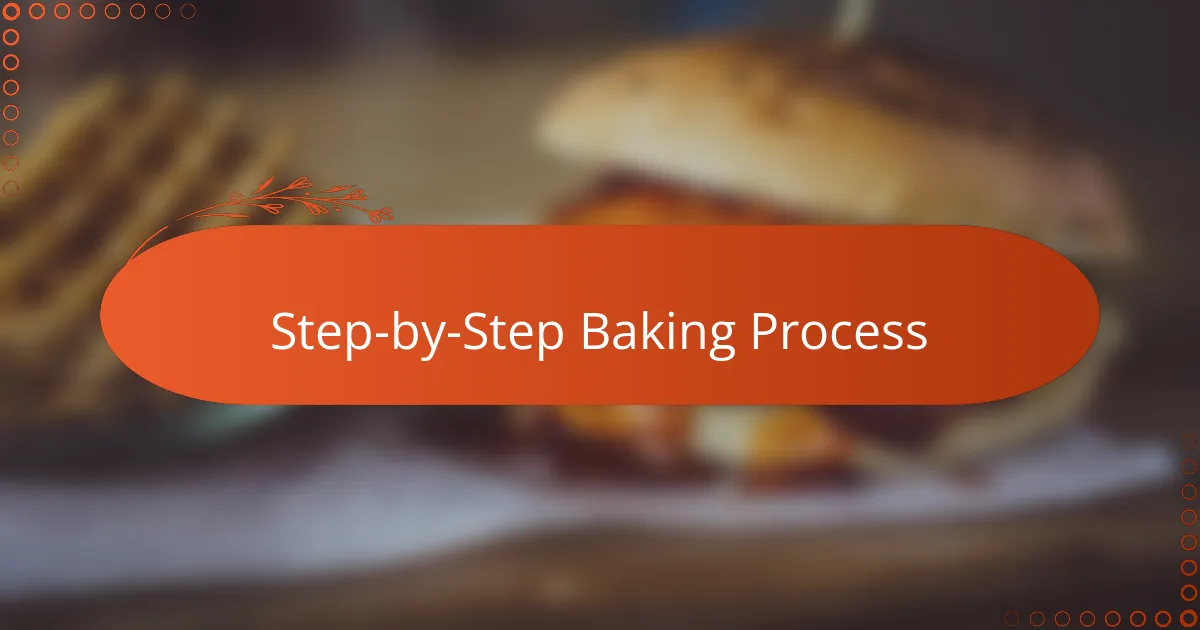Key takeaways
- A sourdough starter is a unique living culture that reflects its environment and the baker’s habits, resulting in distinct flavors in every loaf.
- The core ingredients for sourdough bread are simple: sourdough starter, flour, water, and salt, with flour type significantly influencing texture and rise.
- Maintaining the starter requires regular feedings and attention, and it thrives best at a warm temperature, which is crucial for successful fermentation.
- Observing the dough’s rise and texture, rather than strictly following time, teaches patience and enhances the baking experience.

Understanding Sourdough Starters
A sourdough starter is more than just a mixture of flour and water; it’s a living culture that captures wild yeast and beneficial bacteria from the environment. When I first began nurturing my starter, I was fascinated by how these invisible microorganisms transform simple ingredients into a bubbling, tangy base for bread. Have you ever wondered how something so basic can bring such depth of flavor and life to baking?
Maintaining a starter feels almost like caring for a pet—there’s a routine and a kind of connection that forms over time. I’ve found that watching my starter rise and fall each day teaches patience and attentiveness, reminding me that good things often require care and consistency. Isn’t it amazing that this natural process, rooted in tradition, connects us directly to centuries of bakers before us?
What really excites me about sourdough starters is their unique personality. No two starters are exactly the same because they reflect the local environment and the baker’s own habits. This means every loaf you bake has a story, a distinct character that can’t be replicated precisely anywhere else. Doesn’t that make baking with a starter feel honest and deeply satisfying?

Ingredients for Sourdough Bread
When I first gathered the ingredients for my sourdough bread, I was surprised by how simple the list was: just sourdough starter, flour, water, and salt. It seemed almost too basic, but that simplicity is part of what makes sourdough so magical. Have you ever marveled at how these few humble pantry staples can come together to create a crusty, flavorful loaf?
Flour is a critical player here, and I’ve learned that the type you choose really matters. I usually opt for bread flour because of its higher protein content, which gives the dough strength and chewiness. It’s interesting how such a small choice can change the whole texture and rise of the bread—don’t you find that fascinating?
Salt might feel like a minor detail, but it’s essential. It controls fermentation and enhances flavor, balancing the tang of the starter. I recall the first time I forgot to add enough salt—I ended up with a loaf that tasted flat and lacked that satisfying depth. Since then, I never underestimate the power of just a little pinch. Have you experienced how these tiny adjustments make all the difference?

Preparing the Starter for Baking
Before diving into baking, I always make sure my starter is at its peak—active, bubbly, and ready to work its magic. I’ve noticed that feeding it about 4 to 6 hours before mixing the dough gives it enough time to become lively but not over-fermented. Have you ever seen that perfect dome of bubbles forming? It’s the starter’s way of saying, “I’m ready!”
Sometimes, I weigh my starter to ensure I’m using the right amount for the recipe. It feels almost scientific, but honestly, it’s just a habit that keeps my bread consistent. Plus, it’s exciting to measure out the exact living culture that will transform flour and water into something extraordinary.
Before adding it to the dough, I like to give my starter a gentle stir. It’s a small act that helps me connect with the process—reminding me that behind every loaf is a thriving community of yeast and bacteria ready to create that beautiful rise. Does it feel a bit like nurturing a secret ingredient? Because that’s exactly what it is.

Step-by-Step Baking Process
Once my starter is bubbling and ready, the very first step is mixing it with flour and water to form the dough. I remember how nervous I was the first time, worrying if the proportions were right, but it’s amazing how the dough begins to come alive under your hands. Have you noticed how the texture changes from sticky to smooth as you knead?
Speaking of kneading, I find it’s one of the most satisfying parts of the process. It’s almost like a dance between my palms and the dough, developing gluten that gives the bread its structure. When I feel that elastic bounce, I know I’m on the right track—don’t you think kneading connects you in a special way to your loaf?
After kneading, I let the dough rest and rise in a warm spot—a stage called fermentation—that can test your patience. Watching the dough double in size feels like witnessing magic unfold, and it’s a quiet reward reminding me that time and care are the true ingredients here. Have you ever timed the rise by the dough’s perfect puff instead of the clock? It’s a lesson in trusting the process.

Troubleshooting Common Issues
Sometimes, despite all the care, your sourdough starter might not rise as expected. I remember one morning when my starter looked lifeless, and I panicked—only to realize it was a matter of temperature; starters thrive best around 75°F (24°C). Have you noticed how a slight chill in the room can slow everything down? Keeping your starter cozy can make all the difference.
Another common hiccup I’ve faced is dough that feels too sticky or too dry. It’s tricky because flour absorption varies, and sometimes adding just a tablespoon more water or flour can turn the dough from frustrating to perfect. Have you had moments when you thought your dough was doomed, only to save it with a small adjustment? Trusting your hands and intuition here is key.
Occasionally, my bread comes out denser than anticipated, and that’s usually because the fermentation timing was off. Waiting too long—or not long enough—can affect that airy crumb we all crave. I’ve learned to watch the dough closely, not just the clock; if it jiggles and springs back gently, it’s ready. Isn’t it amazing how baking teaches us patience and observation every step of the way?

Storing and Maintaining Starters
Storing my sourdough starter in the fridge has been a game-changer for me, especially when life gets busy. I usually feed it once a week, and even after days of neglect, it bounces back lively with just a few feeds. Have you ever been surprised by how resilient your starter can be? That toughness always reminds me that this little culture is truly alive.
Maintaining the starter’s health is all about regular feedings. I’ve found that setting a simple schedule—discarding a portion and refreshing with equal parts flour and water—keeps my starter happy and predictable. Sometimes, I catch myself procrastinating, but then I remember how rewarding it is to see those bubbles form, signaling vitality. Doesn’t that tiny sign of life feel almost like a little victory?
Occasionally, I like to keep my starter at room temperature if I plan to bake soon, which requires daily feedings. It demands attention, yes, but I enjoy that rhythm. Have you noticed how the starter develops a stronger aroma and more bubbles when nurtured this way? It’s like sharing a moment with a living thing that, in turn, gifts you warmth and comfort in every loaf.



